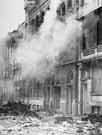
|
|
|

|

|

|

|
|
Click on an image to see a larger, more detailed picture.
|
|
|
|
|
| 1941: Mass Murder |

|
pg. 228 |

|
|
|
|
| |
 A Belgian firefighter surveys the wreckage in the wake of the "Antwerp pogrom" of April 1941. Given the go-ahead by the German occupation authorities, Belgian antisemites looted and pillaged the Jewish neighborhood of Antwerp. Their orgy of violence destroyed two synagogues and the home of Rabbi Marcus Rottenberg, and shattered the lives of many Belgian Jews.
A Belgian firefighter surveys the wreckage in the wake of the "Antwerp pogrom" of April 1941. Given the go-ahead by the German occupation authorities, Belgian antisemites looted and pillaged the Jewish neighborhood of Antwerp. Their orgy of violence destroyed two synagogues and the home of Rabbi Marcus Rottenberg, and shattered the lives of many Belgian Jews.
Photo: Belgium Radio and TV / United States Holocaust Memorial Museum Photo Archive
|
 Sitting in this Venetian gondola are Italian government officials Luca Pietromarchi (front left) and Raffaele Casertano (rear left). An unidentified Croatian Ustasa official sits on the right. The Croats and Italians were participating in the festivities surrounding Croatia's signing of the German-Italian-Japanese Tripartite Pact. The Croatian Ustasa regime under Ante Pavelic killed Jews, Serbs, and Gypsies. Hundreds of thousands were killed, including 80 percent of Croatia's Jews. Ironically, it was the Italian Army that helped save thousands of Croatian Jews.
Sitting in this Venetian gondola are Italian government officials Luca Pietromarchi (front left) and Raffaele Casertano (rear left). An unidentified Croatian Ustasa official sits on the right. The Croats and Italians were participating in the festivities surrounding Croatia's signing of the German-Italian-Japanese Tripartite Pact. The Croatian Ustasa regime under Ante Pavelic killed Jews, Serbs, and Gypsies. Hundreds of thousands were killed, including 80 percent of Croatia's Jews. Ironically, it was the Italian Army that helped save thousands of Croatian Jews.
Photo: Yad Vashem / United States Holocaust Memorial Museum Photo Archive
|
 Iraq and the Holocaust
Iraq and the Holocaust
In the late 1920s 120,000 Jews lived in Iraq, including 90,000 in Baghdad alone. Jews coexisted peacefully with their fellow countrymen until 1932, when the British Mandate in Iraq came to an end. Iraq suffered political instability for the next decade. Nationalism was on the rise, as was a hatred for foreigners and minorities. Fritz Grobba, the German minister to Baghdad, infiltrated the city with antisemitic propaganda. Discriminatory laws against Jews began in 1934, and assaults and pogroms occurred two years later. A pro-Nazi government led by Rashid Ali al-Gaylani rose to power on April 1, 1941, and sporadic assaults on Jews followed. The new government fell weeks later, with British troops occupying Baghdad on May 30. On June 1, however, furious Iraqi soldiers instigated a city-wide riot against Jews. All told, 179 people were killed and more than 2000 were injured. A new government restored order, but tensions among Muslims and Iraqi Jews (many of whom chose to emigrate to Shanghai, China) continued in Iraq for years.
Photo: Moshe Baruch / Beth Hatefutsoth
|
|

|

|

|

|
 April 17, 1941: In Warsaw, a Jewish policeman named Ginsberg is bayoneted and shot by German soldiers after asking a soldier to return a sack of potatoes taken from a Jewish woman.
April 17, 1941: In Warsaw, a Jewish policeman named Ginsberg is bayoneted and shot by German soldiers after asking a soldier to return a sack of potatoes taken from a Jewish woman.
|
 April 18, 1941: Yugoslavia capitulates to the Germans.
April 18, 1941: Yugoslavia capitulates to the Germans.
|
 April 21, 1941: A mentally ill Jewish woman in the Lódz (Poland) Ghetto complies when a German sentry orders her to dance. Satisfied, the sentry shoots her in the head.
April 21, 1941: A mentally ill Jewish woman in the Lódz (Poland) Ghetto complies when a German sentry orders her to dance. Satisfied, the sentry shoots her in the head.
|
 April 24, 1941: One hundred Jews are seized in the Warsaw Ghetto to dig canals and drain swamps in Poland's Kampinos Forest.
April 24, 1941: One hundred Jews are seized in the Warsaw Ghetto to dig canals and drain swamps in Poland's Kampinos Forest.
|
|
|
|
|
| 1941: Mass Murder |

|
pg. 228 |

|
|
The Holocaust Chronicle
© 2009 Publications International, Ltd.
|
|
